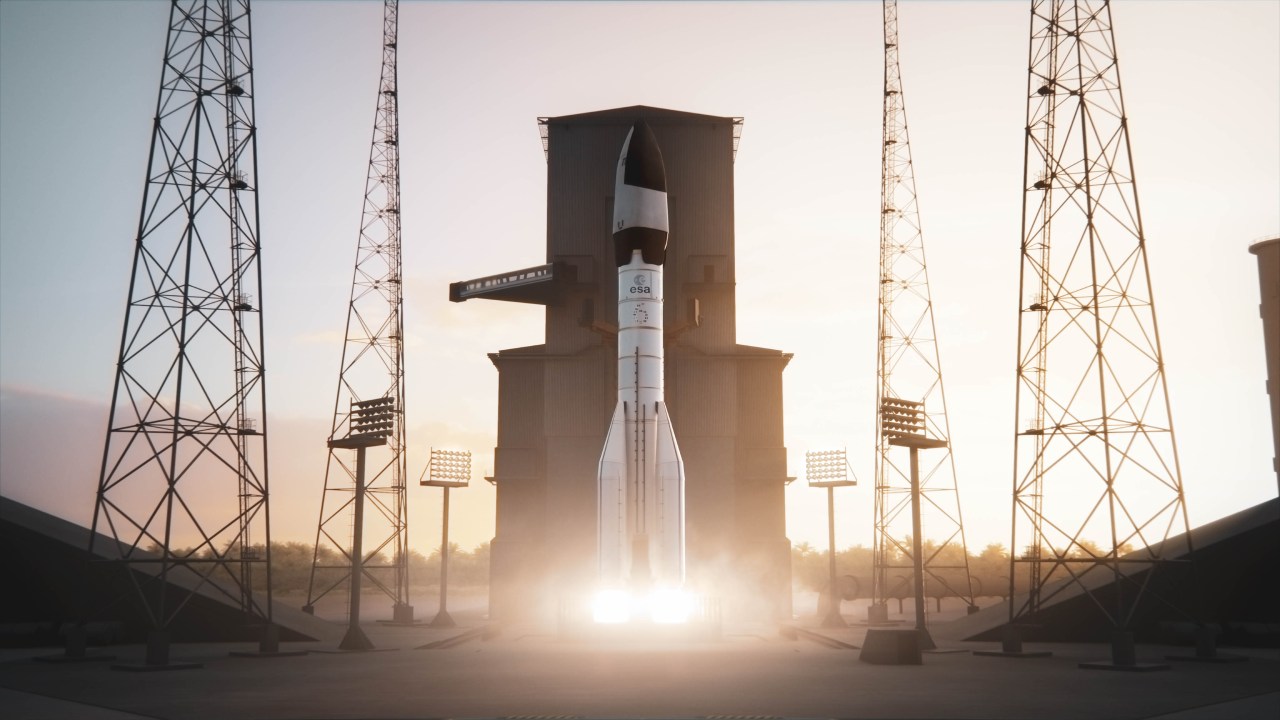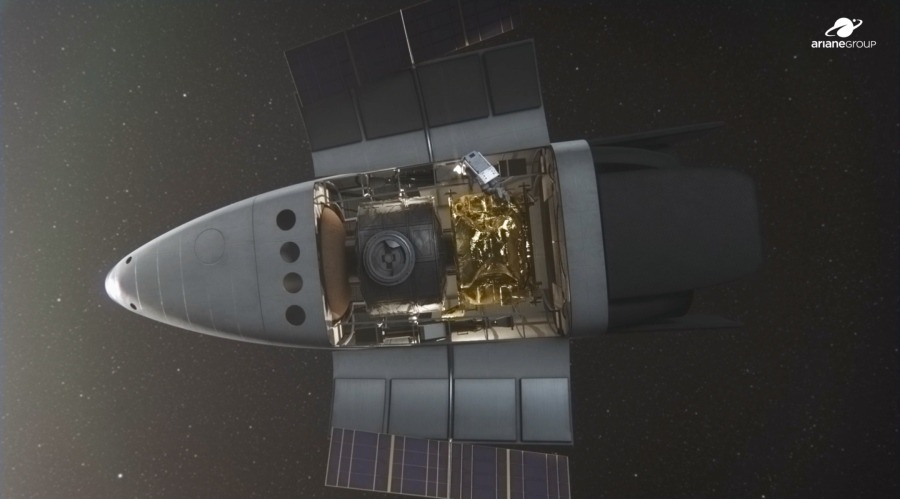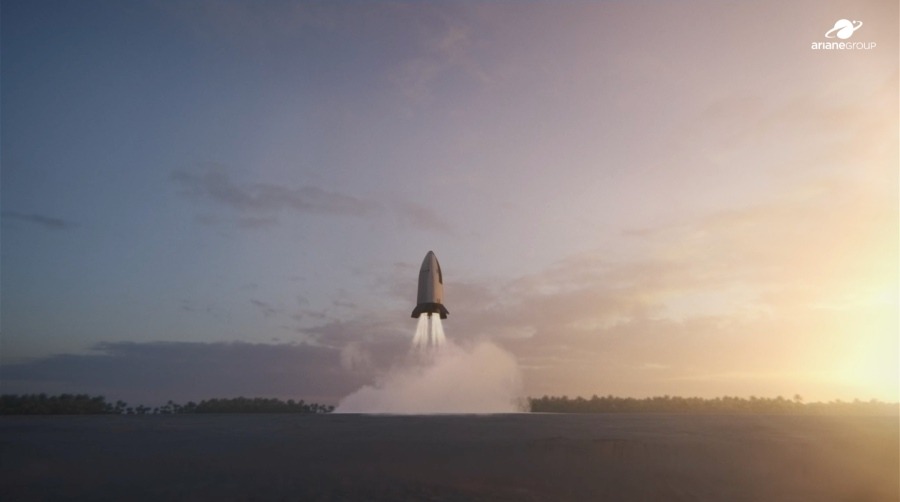SUSIE, THE REUSABLE SPACE TRANSPORTER – EUROPEAN STYLE
07.11.2022

With Susie, ArianeGroup offers Europe an all-new, smart, reusable upper stage concept, compatible with Ariane 6 and with the subsequent generation of European launchers. A stage such as this meets the future needs of both automated freighter and crewed flight missions, to, in and from space, and would contribute to enhancing Europe’s strategic independence.

@ArianeGroup – Susie at lift-off on Ariane 6
A study of future space transport needs shows that how we access space and work there will change radically in the coming years. (See the article A family of reusable and eco-friendly launchers for Europe.) The ability to move easily around in space in order to perform a variety of missions in orbit, go to the Moon and beyond, and then return to Earth, is becoming a key factor in the strategic independence of a space-faring nation.
The lunar orbital station (Lunar Gateway) that the US NASA and European ESA space agencies are in the process of developing will be deployed in the 2030s and will continue to evolve. It will act as a forward base for activities on the Moon’s surface and potentially for the in-situ exploitation of resources (see ESA’s ISRU (In-situ resource utilisation) project which aims to demonstrate the technologies needed to exploit the resources available on the Moon, in particular to produce oxygen and water in-situ), but also as a base for assembling and then dispatching spacecraft for future missions to Mars and deep space. Exploration will thus play a key role in the development of space infrastructures, as ESA demonstrates in its strategic document entitled “Terrae Novae”. New orbital infrastructures will be deployed around the Earth, including for the manufacture of objects, materials or drugs, the production of which requires a microgravity environment.

@ArianeGroup – Susie docked with an orbital station
This is why ESA and the European Commission are calling for renewed space ambitions in Europe, in terms of exploration and crewed flight, and have launched initiatives accordingly.
Essential missions to, in and from space
In this context, ArianeGroup is proposing Susie (Smart Upper Stage for Innovative Exploration), a new and entirely reusable launcher upper stage concept, designed to meet the future needs of transport to, in and from space. Susie will replace the launcher’s fairing and will be able to operate as an automated freighter or perform crewed missions with up to five astronauts.

@ArianeGroup – Susie with cargo bay open
Susie is a flexible, modular, safe, and reliable vehicle and will be able to perform numerous vital missions in space, such as towing, inspection or upgrading of satellites and other payloads, as well as resupplying space stations with fuel, food, and equipment. It will also be able to carry out crew changeovers and facilitate human in-orbit activities. Further down the line, it enable the in-orbit construction and servicing of large infrastructures. It will also help reduce space debris and assist with removing or de-orbiting end-of-life satellites.
Susie is fully integrated and comprises all mission functions, making it totally reusable. In conjunction with its considerable versatility, this represents a major difference with respect to more traditional capsule type concepts, notably in terms of competitiveness and economic sustainability.
On Ariane 64 and the launchers of the future
Susie is designed to fly in a few years’ time on Ariane 64, and in the longer term on the following generation of European launchers. With Ariane 6, Europe will soon have an extremely powerful, flexible rocket designed to evolve by incorporating new technologies and capabilities. It will be easy to replace the fairing and upper composite with a Susie. The vehicle’s dimensions are compatible with the launcher, and its 25-ton lift-off mass corresponds to the Low Earth Orbit (LEO) performance of the 4-booster version equipped with the P120C+ solid fuel engine.

@ArianeGroup – Susie in orbit
Susie can also be developed incrementally, beginning with the automated freighter version. In this case, no modification would be needed, either to the Ariane 6 launcher, or to the launch pad or mobile gantry. The version carrying a crew of astronauts could enter service subsequently, with the launcher being qualified for crewed flight in the meantime and modifications being made to the ground segment.
Susie is also designed for after Ariane 6: it is a key component of the launcher family project proposed by ArianeGroup and its partners to ESA, under its NESTS (New European Space Transportation Solutions) initiative. Susie is consistent with ongoing and future technological developments and will pave the way for entirely reusable launchers.
Bringing a seven-ton payload back to Earth
Susie’s fuselage is actually a “lifting body” which generates lift during atmospheric re-entry. It will thus be able to surf the upper layers of the atmosphere at high speed (in excess of Mach 25) and then make a re-entry that is comfortable for the astronauts. This also offers the level of control needed for a precision landing. The crew will feel an acceleration of about 2.5 g, which is less than that experienced on most roller-coasters, and far less than that felt inside a space capsule. After its atmospheric re-entry, Susie will turn around, extend its aerodynamic surfaces and deploy its landing gear for a vertical landing using its controlled thrust engines, on a landing zone at Europe’s Spaceport in Kourou, French Guiana. It could also potentially land anywhere in the world.
In its crewed version, Susie will have an ejection system covering all phases of the flight, from lift-off to landing, offering the crew end-to-end safety throughout the mission. The system could even be activated on the ground, similarly to a fighter aircraft’s ‘zero-zero’ (zero speed/zero altitude) ejector seat.
Finally, Susie’s bay offers a respectable and entirely configurable volume of 40 m3, able to accommodate and organize numerous types of payloads according to the missions to be performed in orbit, whether automatic freighter or crewed. Both at lift-off and on the return, Susie can carry seven tons of equipment, assorted material or products, or indeed return them to Earth, in perfect condition. This also includes a crew and its life support systems in crewed mode.

@ArianeGroup – Susie at landing
Susie, long-range space cruiser
For future long-duration automated or crewed missions to deep space, the Moon or other planets in the Solar System, Susie can be converted into a “space train”. To do this, it is coupled with a transfer module fitted with engines for long-distance cruise, propellant tanks, electrical power from solar panels, and life support (air, water, food, etc.). In this configuration, Susie could for example reach the lunar orbital station, then return to Earth and land, while the transfer module remains in Earth orbit, where it would be reconditioned for the next flight.
Characteristics of Susie
- Length: 12 meters
- Width: 5 meters
- Lift-off mass: 25 tons
- Bay capacity: 40 m3
- Useful payload at lift-off: 7 tons
- Useful payload at landing: 7 tons
- Crew: 5 astronauts